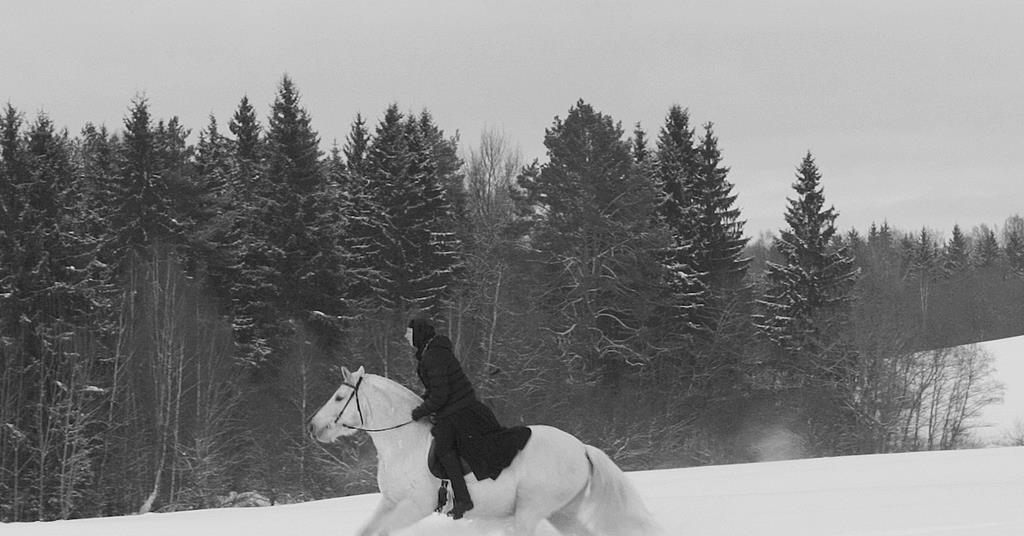Dir. Cécile Embleton, Alys Tomlinson. UK. 2024. 91 minutes.
The phrase ‘stranger than fiction’ is to be dealt with with care, however one suspects that it not occasionally applies to the paths main people to the life monastic. That’s actually the case with Mom Vera, premiering in Visions du Réel – a portrait of a Belorusian nun, the world she inhabits and her singularly fraught journey of self-realisation.
Transfixingly lovely movie… is a should for festivals
Shot in black and white with a coda in color, this transfixingly lovely movie is a documentary, however imbued with the contemplative narrative drift related to ‘gradual cinema’ fictions. It is going to be a should for festivals, particularly any with feminist or ecumenical pursuits; as a portrait of feminine non secular points, it might have related distribution potential to latest art-house hit Smoke Sauna Sisterhood, in addition to tapping the congregation that flocked to 2005 monastic documentary In Nice Silence.
Mom Vera is a debut for each its administrators – French-British documentarist Cécile Embleton, whose shorts embrace 2016’s The Watchmaker, and acclaimed British photographer Alys Tomlinson, whose religiously-themed picture venture ’Ex-Voto’ (2019) was the place to begin for this examine.
The movie begins with a protracted take following an unidentified determine pacing up corridors and staircases in a heavy black gown, earlier than falling to the ground kneeling in such a approach that individual and gown appear to be one single mass. An extended sequence of impressionistic chiaroscuro photos follows – candles in darkness, metallic balustrades, crowds of figures in monastic cloaks with the distinctive flat-topped Orthodox headpieces – then the sound of cantillation, a ringing chant on one monotone however reverberant observe. With Leonardo Cautereccio’s spare sonic texturing (bells, wind, horses’ hooves, voices), Mom Vera communicates as richly in sound, and certainly silence, because it does in photos.
When the movie’s central determine totally comes into focus, it’s as a face hovering in darkness, her pale, light options standing out from the darkness of her cowl, making her resemble one of many painted icons seen all through the movie. She is a nun,m Mom Vera, who’s then seen driving a white horse by snowy fields. Practically all the pieces up thus far might recommend a fictional reconstruction of the distant previous: Tarkovsky’s Andrei Rublev inescapably involves thoughts. However then it turns into clear that we’re within the current day, as we see a Christmas social occasion at which Vera and different nuns and clergymen work together with native folks, together with a younger man with Down’s Syndrome.
in short sections of voice-over within the Belorusian language – delivered confessional-style in light sotto voce – Vera reveals her previous and explains what introduced her to the convent (though not specified, it’s located in Belorusia, close to Minsk). On the age of 20, she lived a cosmopolitan life that concerned nightclubs, motorbikes and a prison husband, Oleg, whom she says went to jail due to her. She confesses that she robbed, destroyed folks’s lives, bought different ladies hooked on medicine; even as we speak, after 20 years of monastic life, she says, “I have to be from hell”. In a outstanding passage, she describes her heroin use virtually by way of spiritual transcendence, earlier than revealing how the drug then confirmed her its demonic aspect.
This convergence of excessive spirituality and underworld degradation – a theme with explicit Slavic, to not say Dostoevskian, resonance – comes into focus at a gathering attended by a roomful of males who, we be taught, are on the monastery for rehabilitation. They’re ex-convicts who discuss concerning the pariah standing of prisoners seen as weak (‘downcasts’, because the subtitles put it), earlier than a priest sternly addresses them on all being equal earlier than God. The scene additionally options sly asides between Vera and one other nun; saintliness however, the latter will get positively flirty in her observations of a number of the males current.
Vera, named Olga in her earlier life, can be seen together with her household – mom, sister and nephews. In an irresistible sequence, she and her sister take a stroll by a pine forest, along with a donkey, its foal and a younger sheep, the latter two irrepressibly larky.
Shot by each administrators, the movie is wealthy in single photos that stand out with poetic depth, generally held, generally fleeting: a close-up of Vera’s hand fingering a rosary, a shot of a monastery window that may very well be a mediaeval scene, if not for the economic chimneys seen on the horizon. The dominant mode is a extremely textured, generally frosty vary of greys, recalling Bela Tarr’s later movies, however with stark distinction in some sequences, each within the chiaroscuro interiors and within the pictures of black-cloaked Vera galloping throughout fields of snow.
Then, some 20 minutes earlier than the tip, the movie gently transitions into color, and appears to turn into a special movie completely – following Olga/Vera into a really completely different world and self-discipline. No spoilers right here, besides to say that it turns into clear that her private quest by secular and spiritual worlds is much from over.
Manufacturing firm: She Makes Productions
Worldwide gross sales: She Makes Productions, laura@shemakesproductions.com
Producer: Laura Shacham
Cinematography: Cécile Embleton, Alys Tomlinson
Editors: Romain Beck, Cécile Embleton
